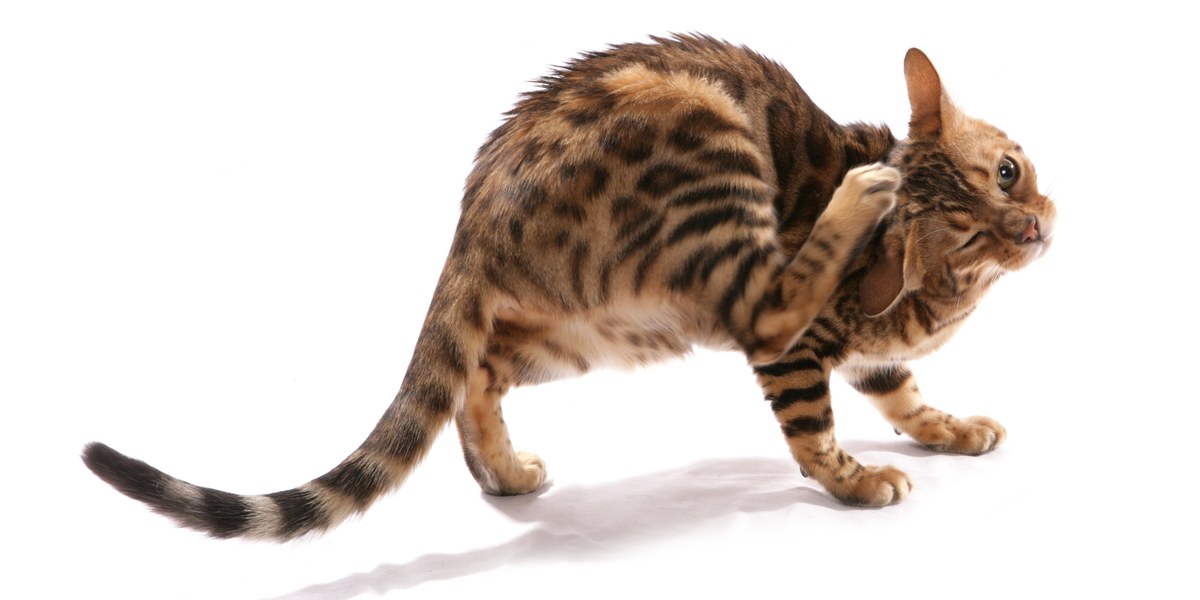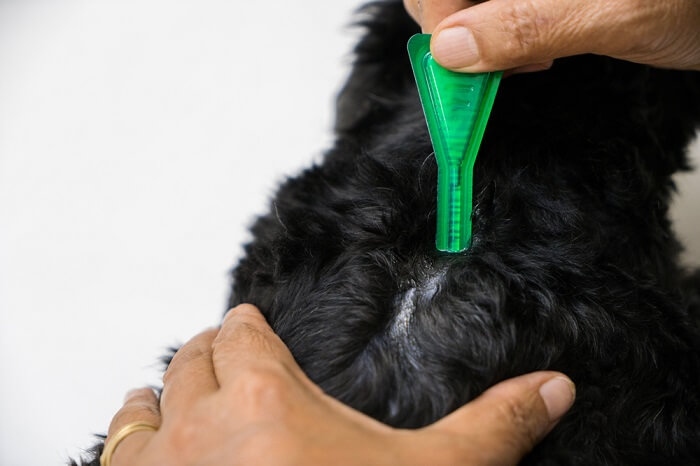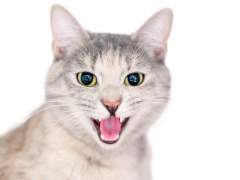Capstar is a brand name for an over-the-counter oral adult flea insecticide called nitenpyram, made by the company Elanco. In this article, you’ll learn what Capstar does for cats, how it works, potential side effects, dosing information, and some frequently asked questions.
Capstar for Cats Overview

About Capstar for Cats
Capstar is a brand name for the active ingredient nitenpyram, which is an oral insecticide medication that targets only adult fleas.
Nitenpyram is in the class of neonicotinoid insecticides. When the medication enters a flea’s circulation after it bites a treated cat, the drug binds to receptors in the flea called nicotinic acetylcholine receptors.
Acetylcholine is a neurotransmitter responsible for many functions including muscle movement and central nervous systemic function. When nitenpyram blocks acetylcholine’s function, this leads to paralysis and death of the flea.
What Does Capstar Do for Cats?
Capstar kind of gets the ball rolling on treating a cat for fleas, but it only kills adult fleas and has no effect on flea eggs or larvae. However, it is considered very safe to use and starts working within 30 minutes. Reportedly, it has a 99% kill rate for adult fleas within 3 to 6 hours of being given.
Capstar is most often used as a fast-acting way of killing adult fleas on a kitty to provide some immediate relief from their biting, prevent adults from jumping over to other pets, and stop egg-laying and perpetuation of the flea life cycle.
Practically, a single dose of Capstar is often used in a veterinary office if fleas are seen on a cat, so that all the adult fleas can be killed and the risk of any jumping to other patients in the hospital is reduced, keeping any potential spread of fleas in a clinic or hospital isolated.
Capstar also makes it easier to bathe and clean a cat with a bad flea infestation, when all of the adult fleas are dead.
Capstar is only effective for about 24 hours, making it not the best choice for eliminating a full flea infestation, because it is very short-acting and has no effect on eggs or larvae.
If Capstar alone was used to treat for fleas, all the eggs laid and larvae that exist on a cat or in the home environment would develop into adults days or a couple weeks later. When flea eggs or larvae are not being treated, it often takes much longer to rid a cat and the home environment of fleas.
Side Effects of Capstar for Cats
Despite being a very safe drug, some adverse effects have been reported, including hyperactivity, panting, lethargy, itching, vocalizing, vomiting and decreased appetite.
Capstar tablets are labeled for use in cats and kittens weighing 2lb or more and older than 4 weeks of age.
Capstar is considered to be a very safe drug to use. Reportedly, nitenpyram is 3500 times more selective for the nicotinic acetylcholine receptors in insects compared to vertebrates like cats, dogs, and humans, making it very unlikely to exert any of its effects on a host kitty.
Capstar has also been studied using 10 times the labeled dosage for 30 days without adverse effects being seen.
All the same, adverse effects have been reported, including hyperactivity, panting, lethargy, itching, vocalizing, vomiting, decreased appetite, hypersalivation (drooling), incoordination, seizures, dilated pupils, elevated heart rate, and trembling.
It is thought that at least some of these signs may be more associated with the die-off process of affected fleas vs. being secondary to the medication itself. Because Capstar kills fleas quickly and has a short, 24 hour range of efficacy, the side effects are usually self-limiting and resolve without any treatment.
More serious side effects were more commonly seen in cats weighing less than 2 pounds, and those who are thin or emaciated. Although labeled for cats older than 4 weeks of age, Capstar should still be used cautiously in cats less than 8 weeks old.
Nitenpyram has also been considered one of the safest flea medications to use for breeding, pregnant, and lactating animals. While birth defects and neonatal loss have rarely been reported, the risk is considerably lower compared to use of other flea medications.
Capstar for cats is safe to use with other flea treatment/preventative medications, and in fact concurrent use is common given Capstar’s limited range and duration of effect. For example, it is common to give a cat a dose of Capstar to provide a quick kill of adult fleas, followed by use of a topical medication that will last for at least 30 days, like Revolution, Advantage II, or Frontline.
Capstar for Cats Dosage
In cats that are difficult to administer a tablet to, Capstar can be crushed or dissolved in a very small amount of water and given orally by syringe.
According to the manufacturer, cats weighing 2-25 pounds of body weight should get one of the 11.4mg tablets once by mouth. It is safe to repeat this dosage as often as every 24 hours, and may be given with or without food.
Anecdotally, in cats that are difficult to administer a tablet to, Capstar can be crushed or dissolved in a very small amount of water and given orally by syringe.
When Capstar is the sole method of flea treatment (which as mentioned is less effective than other methods), protocols may range from giving it once per day to once per week to control the presence and re-emergence of adult fleas as eggs hatch and larvae mature.
Conclusion
Capstar for cats is a great, safe medication to use as part of a flea treatment program for cats. However, its short duration of effect and limited ability to only kill adult fleas makes it a less ideal choice as a sole means of treating fleas.
Drug Dosing Disclaimer: We are only able to provide doses for medications that are FDA approved for use in cats and only as the label guidelines dictate. For medications that are used off-label we can only provide guidelines and safety information for use. Safe and appropriate dosing for off-label medications can only be determined by a primary care veterinarian.
We encourage you to work with your veterinarian to determine if a particular medication is appropriate for your cat. Changing or adjusting a dose for your cat on your own without consulting with a veterinarian can carry risk. We do not encourage use of medications prescribed for human use in pets without first consulting with a primary care veterinarian.
Frequently Asked Questions
How Long Does Capstar for Cats Last?
Capstar only lasts for about 24 hours after it is given. However, as per the label, it can be redosed every 24 hours if needed.
Do Vets Recommend Capstar for Cats?
Veterinarians do often utilize and recommend Capstar for cats, but it is important to understand its use and limitations. It can be very safe to use for very young kittens as long as they are at least 4 weeks old and 2lb in weight. It can also be useful to use for pregnant or lactating queens.
Since it starts working in 30 minutes, we often use it as a “quick kill” method when a cat in the vet office is found to have fleas, as a way of killing the adults and limiting the risk of a flea outbreak in the hospital. It is also a good way of getting the ball rolling so to speak on treating fleas by quickly killing off all adult fleas in just a couple hours.
However, it is not great to use on its own to control a flea infestation in the home. Using a product like Revolution, Frontline, Advantage II, or other approved flea treatment/preventatives for cats that work for at least 30 days are more successful at addressing infestations because they work longer and target other parts of the flea life cycle.
Does Capstar Kill Fleas or Just Make Them Jump Off?
Capstar definitely kills fleas, but it is important to remember that fleas do have to bite and consume a blood meal to get the medication into their system. Since this is basically all that fleas do, they still die very quickly from Capstar, but Capstar does not provide any “kill on contact” or repellency.
How Often Can You Give a Cat Capstar?
Per the manufacturer, Capstar can be given every 24 hours if needed. Cats given 10 times the prescribed dosage for 30 days in trials showed no adverse effects. Nitenpyram has about 3500 times more selectivity for insects and levels are not thought to accumulate over time in the body, making it a generally safe medication to use.











Can this medication be crushed and given with a small amount of wet cat food.
Yes, you can crush Capstar and feed it in your cat’s food. It’s just important to make sure that they get the entire tablet for full effect.
I gave my new kitten capsize because he was filled with fleas around the neck area. I got him from outside, and I did not know how many fleas his cat had on him, but the cat was crying once the medication was ingested, and was scratching and licking himself when a cat licks himself does the dead flies does he eat the dead fleas or does he ingest the dead fleas?
Hi Barbra,
With cats being such fastidious groomers, they will definitely ingest fleas. It can be a part of the reason why cats with a bad flea bite allergy sometimes appear to have no fleas visible. If there’s a lot of fleas I do think it’s important and helpful for the cat to have a bath after the Capstar has killed the adult fleas, either using dishsoap or a non-irritating shampoo made for pets. This gets adult fleas, flea dirt, and hopefully some flea eggs out of the fur. You’ll also want to start a monthly flea product of some kind since the Capstar has such a short duration of action, to ensure you don’t end up with more fleas that hatch later on.
The other thing to be aware of is that some fleas may carry the Dipylidium tapeworm and cats can get the tapeworm from ingesting an infected flea. If this has occurred, you may see little rice-like segments around your kitten’s bottom or a recent stool about 2-4 weeks later. If this occurs, a tapeworm dewormer from your vet can get rid of them.
Yes i do and it seems to work faster
I know someone who gave capstar to their healthy 5 year old cat and now having seizures.
I remember using it on my cat and told it was safe.
Hi K,
Capstar is considered to be very safe. However, it’s important to remember that any medication considered to be widely safe for most patients can still have rare side effects in a select few.
One of the main reasons Capstar is considered to be so safe is that it is more than 3000 times more selective for insect nerve receptors instead of those for vertebrates. Capstar also doesn’t stay long in the body, being completely excreted in 48 hours.
Many side effects observed in cats are related to the die off of fleas, which can sometimes appear to be neurologic behavior, since cats can do some pretty weird things when they’re itchy or irritated.
If a cat is having true seizures that are persisting, it’s not impossible this is related to Capstar but would indeed be considered unusual to be related to a single dose of Capstar.
Unfortunately true seizures for several days at a very expensive pet hospital.
I’m very sorry to hear that, K. It would be hard to understand Capstar alone as a cause if the drug is excreted fully from the body after 48 hours but seizures have persisted long beyond that. But regardless of cause, I hope the kitty is able to make a recovery.
I administered the monthly topical (fipronil) but a week later have a flea infestation- the cats are inside only and have had flea meds continuously. The Infestation is likely from a cat tree a neighbor gave me. I sprayed it with fipronil as well but cats are scratching a lot and I periodically see some fleas jump on me. Since I already applied a topical recently I do not want to overdose with another application- would capstar help?
Hi B, sorry to hear about this, what a mess for you and your kitties! The short answer is that Capstar can typically be used together with fipronil and in fact many vets will use Capstar initially to kill adult fleas on an infested cat since it can work quickly within 30 minutes, then apply a topical like fipronil for the longer coverage. Capstar doesn’t last very long (24-48 hours) and isn’t a great choice for long-term use because you have to keep redosing it and it only kills adult fleas but not other life stages.
Here are a few things to think about though, before you add more products into the mix. Flea infestations can be obnoxious and take some time to resolve, because there can be hundreds or even thousands of eggs in an environment that keep hatching and releasing new fleas.
It sounds like the cat tree might be the source, as you said. It may have had eggs or pupae on it that emerged after it was moved to your home.
One thing to keep in mind about Frontline and just about any flea control product, is that they don’t provide any repellency for fleas. The fleas must come in contact with the skin (and in many cases they have to bite too) for the product to kill them.
This means that if you have lots of fleas in the home environment, they’re going to jump on and bite everyone, but hopefully if the product is working, they’re dying off before they can lay more eggs. Eventually, all the eggs hatch and you run out of fleas so to speak.
This could explain why you’re seeing so many, because they’re still jumping on and biting your cats even with Frontline. This doesn’t mean the product isn’t working. But you should be seeing dead fleas as the product kills them.
You also shouldn’t be seeing a lot of flea dirt (flea poop) on your kitties, because the fleas shouldn’t be able to take a full blood meal before the product kills them. If you are seeing flea dirt on your cats and no dead fleas at all, I would have more concern that either there may have been an error in application of the product or the product itself is not effective. While considered rare, this has been reported.
It’s vitally important to treat your home environment as well with lots of vacuuming, washing bedding, etc. In some cases, involvement of a professional exterminator may be needed.
It can really be hard to be patient with a flea infestation, but if you really feel like the product is not working well or you need further advice catered to your kitties, make sure to get in touch with your vet.
At one point I had a persistent flea problem while living in an apartment. At that time I took all my pets off of commercial pet food and put them on a homemade diet and 70% of the fleas disappeared. Commercial pet food really ramps up flea production. They say because of all the carbohydrates but I think it also has to do with the hormones and steroids that end up in pet food. If cats are eating what they are intended to eat (meat) then you’re not gonna see fleas because fleas like sugar ( simple carbs).
Also consider that parasites target weaker animals and persistent use of insecticides is going to diminish their health so I’m the long run you would be contributing to the problem. It would be a good idea to regularly detox the cats.
Hi Alison,
Thank you for sharing. You do make good points about unhealthy animals being more likely to succumb to parasites.
The sheer complexity of commercial diet formulation, how many there are, ingredient sourcing, etc. can be overwhelming and confusing, leading many to distrust them and I think there needs to be more science-based information for folks on how diets are made and what goes into that process.
However, there are also nutritional drawbacks to homemade diets, especially for cats, who have unique nutritional needs. Nutritional inadequacies may not be noted in the short term, but can have long-term consequences.
I can’t concur that a simple diet change is going to eliminate a flea infestation. Parasites have been an issue for animals for a very long time, even before commercial diets existed and certainly before flea treatment products existed. I have still seen pets with “natural” parasite treatments and on homemade diets still get both fleas and ticks. Even animals in the wild are regularly affected by parasites of all kinds.
There may be other factors involved with the improvement of the infestation and I also note that the infestation was not mentioned to be fully resolved, though I hope it was. I’m glad you feel that strategy worked for you and your kitties, but point out it comes with its own risks and may not be a viable alternative for everyone.
I’ve found that treating the rooms with Virbac knockout ( wonderful stuff that treats your house for 7 months in a relatively safe way after the initial 2 hours of ventilation and removal of people, pets, and any open food or water sources where it’s been sprayed ) followed by a dose of Capstar for the kittys and lots of vacuuming for two weeks seems to eliminate any outbreak we experience. We used to use the Seresto collars but the last time we used them, all of our cats had terrible skin reactions and one of our cats has a spontaneous hyperthyroid issue immediately following the use of the collars… we try to keep away from anything topically unless it’s our last option. This method works great to get rid of the fleas as long as you diligently spray all areas of the house and vacuum every day for a while. To me.. after our health scares with our fur kids… it’s easy!! Also food grade diatomaceous earth spread in your yard where other pets or people walk… helps from any fleas or eggs being carried inside.
Good tips. Thanks for sharing, Kylie.
Hi,
Do you think I can give my cat capstar tonight and start them on monthly credelio tomorrow???
Hi K,
Using a dose of Capstar to quickly kill adult fleas, followed by starting a monthly treatment/preventative is a very common approach. As an added tip, depending on how bad the flea presence is, after giving the dose of Capstar to kill all the adult fleas (it works within about 30 minutes to an hour) it can help to bathe your cat (if possible depending on the kitty) using a soothing shampoo like an oatmeal shampoo, to remove the dead fleas, flea dirt, eggs, and help with the skin irritation. As an oral product, Credelio is helpful for this, since you would otherwise need to wait at least 24 hours before or after a bath with a topical product.
When crushing up a 11.4 mg.capstar tablet then dissolving in water to be administered in a syringe HOW MUCH WATER. DO U USE WHEN DISSOLVING IN WATER ? FROM WHAT I HAVE READ ANYTHING ABOUT THIS IT IS VERY VAGUE SAYING USE A VERY SMALL AMOUNT OF WATER…..THAT BEING SAID WHAT IS A VERY SMALL AMOUNT OF WATER TO BE USED WHEN DISSOLVING CAPSTAR TABLET TO LIQUID
Hi Randy,
There is no specific volume that’s best. It’s really a balance between the least amount of water to ensure the tablet is fully dissolved and not using so much water that it makes giving it to a cat too difficult.
I would say generally 1ml of water in a 3ml syringe is a reasonable amount as long as the tablet appears well dissolved. You can probably get away with a little less or a little more too. Any volumes more than that can just be problematic for administering. Less than ½ ml may not dissolve the tablet adequately.
The best way to do this is to remove the plunger from the 3ml syringe, insert the tablet, put the plunger back in, then pull back the volume of water, then allow the tablet to dissolve. You can shake the syringe periodically or pull/push the plunger back and forth a little to help dissolve it faster.
I hope that’s helpful to you.
Is capstar safe for my cat that is on medication for congestive heart failure?
I would consult your vet to be on the safe side.
Hello Dr. V,
There are two community cats in my neighborhood that I feed. They both show signs of fleas and I’d like to try treating them. They let me pet them, so I could apply a topical treatment, but I can’t ensure that they won’t lick each other afterwards and ingest some of the medicine. This makes me hesitant to use something like Cheristin. Do you have a suggestion about the best way to safely address their flea issue? I was thinking that perhaps regular doses of Capstar would be good, since it’s oral (no licking risk) and very safe. If you think Capstar is good, would you combine that with anything else (like herbal powders/drops from Earth Animal)? They let me pet them but I can’t wash/bathe them to get ride of the flea eggs, unfortunately. Thanks very much for this article.
Hi Josh! I apologize for the delayed response. I’ll pass this along to Dr. Vanderhoof!
Hi Josh,
Compliments to you on trying to do something for these kitties. Unfortunately, you’ll likely have some barriers or risk with any choice. Captstar will get rid of the adult fleas, but only works for 24 hours, so as you said, it would need to be given on a regular basis to provide any kind of control. You’ll likely continue to have new fleas hatching all the time, so it will be a continuous battle.
A topical product would be much better to provide at least a month of protection and many products include an ingredient with action against flea eggs and larvae as well, which is more effective. There may be some risk with co-grooming after application, though maybe it’s possible these two cats don’t live together or groom each other, they just show up in the right spot for food! I’ve known rescues who take care of feral colonies to use topical products without apparent issue.
Your third choice would be an oral product like Credelio Cat or Comfortis. Only issue there is the need for a prescription.
I’m not the best one to ask about herbal remedies. Topical tea tree oil appeared ineffective in one past patient of mine the owner was using it for. Diatomaceous earth is advocated by some. While using it in the home environment may make sense, I’ve questioned the wisdom of putting it directly on a cat.
Thank you! I ended up using Frontline Plus (topical application), and I hung around them for a while so that they wouldn’t lick each other at least until it had dried/soaked in a bit. As far as I can tell it worked and there were no side-effects.
I gave Capstar to my cat and she has had tremors and seizures. I’m not sure she is going to make it. I would not recommend this
I’m so sorry you’re going through this. Wishing you and your cat all the best.
I gave my new kitten capsize because he was filled with fleas around the neck area. I got him from outside, and I did not know how many fleas his cat had on him, but the cat was crying once the medication was ingested, and was scratching and licking himself when a cat licks himself does the dead flies does he eat the dead fleas or does he ingest the dead fleas?
I have a feral cat I feed, who is pregnant and struggling with itching a lot!
Concerned if I should try Capstar to help her.
Don’t like the idea that she may have seizures because of the application, but want to help her desperately!
Are there any other options?
Hi Rita,
The seizures side effect is considered rare in the grand view of side effects seen with use of Capstar and it has been considered safe for a long time for use in pregnant and lactating cats. The downside of course is that it only works for 24 hours, so a single dose will not make a great impact in the long run and you’d have to continue giving it daily. Another option is a topical product like Frontline which does not get absorbed systemically. If she’ll allow you to touch her safely, this would provide the best flea control. The itching could also be from another cause, though fleas would be my first thought as well.